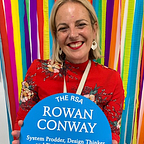The Mayfield Imaginarium
The Mayfield Station was once an integral cog in the transport heart of Manchester, but since its closure in the 60s it has become an abandoned ruin. With its imminent rebirth by developers in sight, volunteers from the Mayfield Imaginarium Collective sought to open the question of Mayfield’s future out to the people of Manchester. Over the course of two days of intense community conversation, Mancunians shared their attitudes towards the development and Mayfield’s place in that ongoing story.
‘The big question is — ‘Is this the city we want to be?’ Here, Clare Devaney talks to Daniel Kelso, Director and co-founder, architecture:unknown to understand the process they are undergoing:
“You start in Salford, head along Deansgate through the heart of the city, pass Central Library, the Town Hall, the universities, the hospitals, up to Rusholme, Withington, Didsbury and this is all basically on the same stretch of road; a route 101 through Manchester, the city in microcosm.
But there’s a conflict between that natural flow and the comparatively static way in which the city is planned. There’s no overarching strategic plan for the city, just for individual areas, so you get development in islands, where individual places might well exist and work — like Spinningfields, like the Northern Quarter — but there’s nothing forcing good — or any — design in between. So if you look at the proposals for the St Michael’s development, for example, which have been controversial and generally poorly received, the development exists in isolation — it doesn’t respond to or interact with anything around it. The emphasis across development in the city appears very much on buy to rent, and not so much on affordability or liveability. The big question is — ‘Is this the city we want to be?’
And there’s a related question about quality and aesthetic. None of the new swathe of skyscrapers really stand out, it’s all fairly standard. There’s this desire here to build, build, build, but it’s hard to find proof of need for that. Only quality will last. There’s a big difference between planned density and building for the sake of it. Why build if you can’t build beautifully?
All of this was influential in our getting involved in the ‘Mayfield Imaginarium’ project, which started with a collective assembled and driven by Adam Prince at Manchester Shield and has brought together architects and designers, artists, activists and academics in exploring and expressing alternatives for the Mayfield site, a disused former rail depot near Manchester’s Piccadilly Station. The site equates to some 4% of the city centre and includes surrounding land and neighbouring buildings including the listed Star and Garter pub, an iconic indie club and music venue.
Through a series of interactive workshops and underpinned by a social media campaign, we have sought to bring a previously limited public voice — and imagination — into the discussions around Mayfield. Our approach throughout has been to encourage different perspectives — both in terms of the diversity of response, and also the questions asked — so, one session was built around how people had arrived at the workshop, which led to an exploration of how we all navigate the city in the different ways; other sessions were more plasticine and prototypes. We had around 120 people at the workshop sessions and have had over 400 responses via the online campaign, which has not only far outstripped the levels of formal public consultation to date, but which has also produced a very different set of priorities. People have spoken to us about fun, about play, about creativity and heritage, and about the potential for features such as the former railway arches to act as hosts to retail, leisure and culture.
Homelessness is a very real and deeply felt concern right around Manchester — and housing, affordability, a place to live featured heavily in our discussions too. At architecture: unknown, we’re developing proposals around self-build housing with key stakeholders around the homelessness agenda, with the view to engaging people with lived experience in the design and build not just of housing, but of communities. There’s a hugely compelling case for not just affordability of living space in the city centre, but for exploring new types of housing models, such as housing co-operatives. One of the difficulties in getting people engaged and passionate about Mayfield is that no-one currently lives there; people tend to be much more active when there’s a development issue around their street or their neighbourhood.
GM Housing Action is just one of the stakeholders who’ve become engaged in the project, and that’s the current focus — getting the key messages out there and getting more stakeholders involved. We were delighted to get a mention from the site developers U+I plc at MIPIM and would love to build on the buy-in and momentum we’ve already generated to be the conduit for public voice in the development going forward.
There’s lots of groups working on similar campaigns at the moment; the trick will be creating a real groundswell of support. The ‘Imaginarium’ model could be applied to all sorts of sites and places across the city and city-region. Ultimately the aim is to see a shift away from the predominant model of ‘consultation’, where people are engaged in retrospect, to a more positive experience where people valued as contributors from the start. Even if the economics wins out, it matters to people that they feel involved. That said, we hope this approach will be the start of something far more meaningful than that — where the whole relationship between architect, planner, developer and community is reconfigured; where community participation comes first.”
